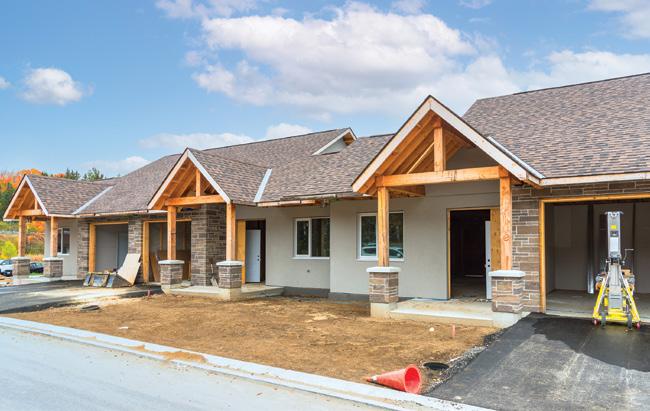

































Ideal placement in the heart of Canada’s industrial hub



Nature enthusiasts appreciate the proximity to parks, trails, and outdoor activities



Affordable living unlocks abundant opportunities for thriving on a budget
A rich history, reflected in its well-preserved architecture and historical sites


Enjoy a high quality of life with a balance of urban amenities and a close-knit community
Choosing St. Thomas means embracing a city that proudly wears its Railway Capital title, offering a distinctive identity and a community spirit shaped by its historical significance



For more information, contact Cathy 519-266-4561 or cfox@dougtarryhomes.com





EMAIL: wayne.karl@nexthome.ca
TWITTER: @WayneKarl
In our Outlook 2024 special report that begins on page 18, we discuss there are early signs that 2024 is shaping up to be a much better year than its predecessor. Housing supply, interest rates, inflation, government policy and other issues were a cause for concern last year, but there was relief already on the horizon.
“I see 2024 bringing a stronger real estate market,” says Deena Pantalone, managing partner and chief innovation officer at National Homes. “The fundamentals are all there. The job market, population growth and income are all healthy and, with the lower sales of last year, there is so much pent-up demand. Remember the old adage, ‘When is the best time to buy real estate? Yesterday.’ All we need is downward movement on interest rates – even a slight lowering – and sales will start to rise again.”
More good news came on Feb. 14, when the Canadian Real Estate Association said there are signs the recovery may already be underway.
“Sales are up, market conditions have tightened quite a bit, and there has been anecdotal evidence of renewed competition among buyers,” says Shaun Cathcart, CREA’s senior economist. “However, in areas where sales have shot up most over the last two months, prices are still trending lower. Taken together, these trends suggest a market that is starting to turn a corner, but is still working through the weakness of the last two years.”
Then on Feb. 20, Statistics Canada released the Consumer Price Index for January, showing that inflation is trending down – to 2.9 per cent on a yearover-year basis, from 3.4 per cent in December.
With such important signposts providing hope, we now await Bank of Canada’s action on interest rates. High inflation was the main reason BoC maintained higher rates than a few years ago, holding its target for the overnight rate at five per cent on Jan. 24.
Most experts were expecting rates to begin declining in spring, so this progress aligns perfectly with the Bank’s next rate announcement on March 6. Rate relief might come then – though more likely on the following announcements on April 10 or June 5 – but it’s clear conditions are improving.
Strong fundamentals, more homebuying activity, pent-up demand –and hopefully very soon – lower rates will spur all kinds of activity on the homebuying and building fronts.
Use this time, then, to prepare and plan your homebuying move, so you’re ready to take advantage when the opportunities arise.






Jesse Abrams is Co-Founder at Homewise, a mortgage advisory and brokerage firm based in Toronto. thinkhomewise.com
Mike Collins-Williams, RPP, MCIP, is CEO West End Home Builders’ Association. westendhba.ca.
Debbie Cosic is CEO and founder of In2ition Realty. She has overseen the sale of more than $15 billion worth of real estate. With Debbie at its helm, In2ition has become one of the fastest-growing and most innovative new home and condo sales companies. in2ition.ca
Mark Cullen is a Member of the Order of Canada, and provides gardening advice to more than two million Canadians each week. Ben Cullen’s specialty is food gardening. markcullen.com; Facebook @MarkCullenGardening and Pinterest @MarkCullenGardening.
Greg Gazin is a syndicated tech columnist, blogger, podcaster, and contributes to canoe.com, Troy Media and Active Life magazine. gadgetguy.ca
Barbara Lawlor is CEO of Baker Real Estate Inc. A member of the Baker team since 1993, she oversees the marketing and sales of new home and condominium developments in the GTA, Vancouver, Calgary and Montreal, and internationally in Shanghai. baker-re.com
Linda Mazur is an award-winning designer and Principal of Linda Mazur Design Group. With almost two decades of experience this in demand multi-disciplinary design firm is known for creating relaxed, stylish spaces and full-scale design builds throughout the GTA and Canada. lindamazurdesign.com @LindaMazurGroup
Jayson Schwarz LL.M. is a Toronto real estate lawyer and partner in the law firm Schwarz Law Partners LLP. Visit online at schwarzlaw.ca or email info@schwarzlaw.ca with your questions, concerns, critiques and quandaries.
Dave Wilkes is President and CEO of the Building Industry and Land Development Association (BILD), the voice of the homebuilding, land development and professional renovation industry in the GTA. For the latest industry news and new home data, follow BILD on Twitter, @bildgta or visit bildgta.ca.
SENIOR VICE-PRESIDENT, SALES, NEXTHOME
Hope McLarnon 416.708.7987 hope.mclarnon@nexthome.ca
DIRECTOR OF SALES, ONTARIO, NEXTHOME
Natalie Chin 416.881.4288 natalie.chin@nexthome.ca
EDITORIAL DIRECTOR
Amanda Pereira
EDITOR-IN-CHIEF – GREATER TORONTO AREA
Wayne Karl wayne.karl@nexthome.ca
CONTRIBUTORS
Jesse Abrams, Mike Collins-Williams, Debbie Cosic, Bilha Kangethe, Barbara Lawlor, Linda Mazur, Jayson Schwarz, Dave Wilkes
EXECUTIVE MEDIA CONSULTANTS
Jacky Hill, Michael Rosset
VICE-PRESIDENT, MARKETING – GTA
Leanne Speers
MANAGER, CLIENT RELATIONS
Sonia Presotto MANAGER CUSTOMER SALES/SERVICE
Marilyn Watling
SALES & MARKETING CO-ORDINATOR
Gary Chilvers BUSINESS DEVELOPMENT MANAGER
Josh Rosset DISTRIBUTION distributionteam@nexthome.ca
ACCOUNTING INQUIRIES accountingteam@nexthome.ca
DIRECTOR OF PRINT MEDIA
Lauren Reid–Sachs
VICE-PRESIDENT, PRODUCTION – GTA
Lisa Kelly
PRODUCTION MANAGER – GTA
Yvonne Poon
GRAPHIC DESIGNER & ASSISTANT MANAGER
Alicesa Pullan
GRAPHIC DESIGNER & PRE-PRESS COORDINATOR
Hannah Yarkony
GRAPHIC DESIGNER
Mike Terentiev
Published by nexthome.ca
Advertising Call 1.866.532.2588 ext. 1 for rates and information. Fax: 1.888.861.5038
Circulation Highly targeted, free distribution network aimed at real estate buyers using street level boxes, racking and Toronto Star in-home delivery.
Canadian subscriptions 1 year = 6 issues – $35 (inc. HST). Canada Post – Canadian Publications Mail Sales Product Agreement 40065416.
Copyright 2024 All rights reserved. All copyright and other intellectual property rights in the contents hereof are the property of NextHome, and not that of the individual client. The customer has purchased the right of reproduction in NextHome and does not have the right to reproduce the ad or photo in any other place or publication without the previous written consent of NextHome.
Editorial Submissions from interested parties will be considered. Please submit to the editor at editorial@nexthome.ca.
Terms and Indemnification Advertisers and contributors:
NextHome is not responsible for typographical errors, mistakes, or misprints. By approving your content and/ or submitting content for circulation, advertisers and contributors agree to indemnify and hold harmless
NextHome and its parent company from any claims, liabilities, losses, and expenses (including legal fees) arising out of or in connection with the content provided, including but not limited to any claims of copyright infringement, unauthorized reproduction, or inaccuracies in the content. Advertisers acknowledge that they have the necessary rights, permissions, and licenses to provide the content for circulation, and they bear full responsibility for the content’s accuracy, legality, and compliance with applicable laws upon approval. Contributors acknowledge NextHome reserves the right to omit and modify their submissions at the publisher’s discretion.

GTA new home sales were slow in December, experiencing marginal growth from December 2022, which was the second lowest December monthly new sales following December 2008, the Building Industry and Land Development Association (BILD) reports.
There were 554 new home sales in December, up 0.5 per cent from December 2022 and 67 per cent below the 10-year average, according to Altus Group, BILD’s official source for new home market intelligence.
“With current interest rates, we are experiencing a hurry up and wait sales environment as potential buyers sit on the sidelines,” says Justin Sherwood, senior vice-president of communications and stakeholder relations at BILD. “Given that housing starts lag pre-construction sales by as much as two years, we can expect that the low level of sales in 2023 will result in lower housing starts in the future. In fact, we are already seeing the pace of housing starts in the GTA
beginning to decline. This will result in less housing supply being added to the market in the near future, aggravating the housing crisis at the same time as we are experiencing increasing demand for new homes.”
“Both new-home buyers and builders remained on the sidelines in December, lacking the confidence to re-engage,” says Edward Jegg, research manager with Altus Group. “As a result, new home sales were sparse and the likelihood for an appreciable uptick in the first half of 2024 remains dim.”
Condominiums, including units in low-, medium- and highrise buildings, stacked townhouses and loft units, accounted for 400 units sold in December, down two per cent from December 2022 and 66 per cent below the 10-year average.
There were 154 single-family home sales in December, up six per cent from December 2022 and 70 per cent below the 10-year average. Single-family homes include
detached, linked and semi-detached houses and townhouses (excluding stacked townhouses).
Total new home remaining inventory decreased compared to the previous month, to 20,252 units. It included 16,850 condominium units and 3,402 single-family dwellings. This represents a combined inventory level of nine and half months, based on average sales for the last 12 months. This is the highest inventory level since 2015, however builders added very little inventory to the market in December in terms of new projects.
Benchmark prices increased in December for both single-family homes and for condominium apartments compared to the previous month. The benchmark price for new condominium apartments was $1.04 million, down 7.5 per cent over the last 12 months. The benchmark price for new single-family homes was $1.60 million, which was down 8.5 per cent over the last 12 months.

The resale housing market showed signs of resurgence in January 2024, with sales rising over January 2023 levels, according to the Toronto Regional Real Estate Board (TRREB).
The annual increase came as some homebuyers started to benefit from lower borrowing costs associated with fixed rate mortgage products. New listings were also up year-overyear, but by a lesser annual rate compared to sales. The resulting tighter market conditions when compared to the same period a year earlier, potentially points toward renewed price growth as we move into the spring market.
“We had a positive start to 2024,” says TRREB President Jennifer Pearce. “The Bank of Canada expects the rate of inflation to recede as we move through the year. This would support lower interest rates which would bolster homebuyers’ confidence to move back into the market. First-time buyers currently facing high average rents would benefit from lower mortgage rates, making the move to homeownership more affordable.”
There were 4,223 sales reported through TRREB’s MLS system in January 2024 – an increase of more than one-third compared to January 2022. The number of new listings was also up year-over-year, but by a lesser annual rate of approximately six per cent. Stronger sales growth relative to listings suggests buyers experienced tighter market conditions compared to a year ago.
On a month-over-month seasonally adjusted basis, both sales and new listings were up. Sales increased more than listings which means market conditions tightened relative to December 2023.
“Once the Bank of Canada actually starts cutting its policy rate, likely in the second half of 2024, expect home sales to pick up even further,”

says TRREB Chief Market Analyst Jason Mercer. “There will be more competition between buyers in 2024 as demand picks up and the supply of listings remains constrained. The end result will be upward pressure on selling prices over the next two years.”
The MLS Home Price Index Composite in January 2024 was down by less than one per cent yearover-year in January. The average selling price was down by one per cent year-over-year to $1.02 million. On a month-over-month seasonally adjusted basis, both the MLS HPI Composite and the average selling price also trended lower.
“While housing market conditions are expected to improve with lower borrowing costs, there are still a
number of policy issues that need to be addressed,” says TRREB CEO John DiMichele. “At the federal level, more reflection on the Office of the Superintendent of Financial Institution mortgage stress test is required, especially to its application at different points in the interest rate cycle. The focus for the province needs to remain on building 1.5 million new homes. At the municipal level, raising property taxes without consistent support from the federal and provincial governments won’t eliminate Toronto’s structural deficit. Helping first-time homebuyers get into the ownership market will ease movement across the entire spectrum and relieve pressure on the rental market.”

Following a weak second half of 2023, home sales over the last two months are showing signs of recovery, according to the latest data from the Canadian Real Estate Association (CREA).
Home sales activity recorded over Canadian MLS Systems rose 3.7 per cent between December 2023 and January 2024, building on the 7.9-per-cent month-overmonth increase recorded the month prior. While activity is now back on par with 2023’s relatively stronger months recorded over the spring and summer, it begins 2024 about nine per cent below the 10-year average.
“Sales are up, market conditions have tightened quite a bit, and there has been anecdotal evidence of renewed competition among buyers,” says Shaun Cathcart, CREA’s senior economist. “However, in areas where sales have shot up most over the last two months, prices are still trending lower. Taken together,
these trends suggest a market that is starting to turn a corner but is still working through the weakness of the last two years.”
National gains were once again led by the Greater Toronto Area (GTA), along with Hamilton-Burlington, Montreal, Greater Vancouver and the Fraser Valley, Calgary and most markets in Ontario’s Greater Golden Horseshoe and cottage country.
The actual (not seasonally adjusted) number of transactions came in 22 per cent higher than January 2023, the largest year-overyear gain since May 2021. However, with current activity still running at below-average levels, the doubledigit gain was more reflective of the base effect from the comparison to January 2023, which was the worst start to almost any year in the past two decades.
“The market has been showing some early signs of life over the last couple of months, probably no
surprise given how much pent-up demand is out there,” says Larry Cerqua, chair of CREA. “There’s a consensus that the market will probably look quite a bit different this year compared to 2022 and 2023, so if you’re hoping to buy or sell a property in 2024, contact a realtor in your area and get your game plan ready today.”
The Aggregate Composite MLS Home Price Index (HPI) fell by 1.2 per cent on a month-over-month basis in January 2024. This represents an acceleration from the 1.1-per-cent decline recorded in December.
Price declines of late have been predominantly located in Ontario markets, particularly the Greater Golden Horseshoe and, to a lesser extent, BC.
The Aggregate Composite MLS® HPI was up 0.4 per cent on a yearover-year basis in January 2024, little changed from readings over the last six months (0.4 to 1.1 per cent).

The GTA housing market will improve in 2024, supported by strong economic fundamentals, according to the Toronto Regional Real Estate Board (TRREB) in its 2024 Market Outlook and Year in Review report and interactive digital digest.
“Demand for ownership housing in the GTA will start improving in 2024,” says TRREB Chief Market Analyst Jason Mercer. “Record population growth, a resilient economy, low unemployment and declining mortgage rates in the second half of the year will result in increased home sales compared to 2023. This will be the start of a multi-year recovery as some households will still face affordability challenges, even as borrowing costs begin trending lower. As the demand for housing picks up, it will be equally important
to see a rebound in the supply of homes for sale and an uptick in new home construction.
“Tighter market conditions will see the average selling price move closer to $1.2 million this year,” adds Mercer. “The second highest mark on record, but still below the 2022 peak.”
The Market Outlook and Year in Review report also takes an in-depth look at the impact of the housing crisis on the mental and physical health of residents, and the need for more housing supply in response to record population growth driven by immigration.
“It’s clear that our regions will only see sustained relief on the affordability front once we remove the roadblocks standing in the way of progress and get shovels in the
ground faster,” says TRREB President Jennifer Pearce. “In the wake of a growing population, policymakers cannot lose sight of planning ahead, and avoid applying band-aid solutions that often result in larger issues than the problems they are attempting to solve.”
“We need to rapidly increase our supply and assist first-time homebuyers with relief on the significant upfront land transfer tax,” adds TRREB CEO John DiMichele. “Prioritizing missing middle housing will provide more diverse and affordable housing options –something we have long called for. All levels of government need to work together and ensure the right incentives are in place for developers to build more housing across the spectrum.”
Catch up between issues at nexthome.ca and enjoy these popular stories

A new condo coming soon to Hastings and Glendale in St. Catharines
Silvergate Homes’ new condominium, Merritton Mills on Hastings in St. Catharines’ Merritton neighbourhood near Glendale, presents a unique opportunity to be a part of the evolving landscape of a thriving community.

Building industry raises concerns over recent Ontario government housing decision
The Building Industry and Land Development Association says it is “extremely disappointed” with the recent announcement by Ontario Minister of Municipal A airs and Housing, Paul Calandra, and calls it a setback for the Greater Toronto Area’s GTA future housing and employment spaces supply.

Barrie no longer just a gateway to cottage country Barrie may have once been best known as the “gateway to cottage country,” but that’s history. Indeed, the days when this city of 153,356 was little more than a popular getaway destination are long over. Barrie has long been a thriving city in its own right, with its own diversified economy and a growing new home destination.

Centralize your home automation devices with ease with Homey Pro smart home hub 2023
Home automation gadgets are supposed to make life easier and more convenient – enter the Homey Pro from Netherlands-based Athom BV, an advanced secure universal smart hub, part of the Homey home automation ecosystem.

How to create a bird feeding frenzy in your backyard Peering out your windows and watching birds feed in your yard is one of life’s simple pleasures. Here are some great tips to attract song sparrows, chickadees and overwintering Blue Jays and Cardinals with a selection of seed options.

Nestled in the heart of St. Thomas, Doug Tarry Homes has been synonymous with unparalleled craftsmanship and innovative design since its inception in 1954. Founded by Doug Tarry Sr., the company has evolved into a beacon of excellence in the homebuilding industry, guided by a philosophy of leaving every place better than it was found – a lesson Doug Sr. imparted during nostalgic family canoe trips.
Doug Tarry Homes understands that every homeowner has unique needs and visions for their living space. That’s why the company offers a diverse range of floorplans, ensuring there’s something for everyone. Whether you’re a single professional, a growing family or downsizing retirees, Doug Tarry Homes’ selection spans from cosy single homes to practical semi-
detached houses and modern townhomes. Each of these options is nestled within award-winning communities, offering not just a house, but a lifestyle supported by community spirit and modern amenities. This variety in floorplans is testament to a commitment to cater to the varied lifestyles and preferences of clients, ensuring each Doug Tarry home is a perfect fit for its owner.
With an ever-growing emphasis on sustainability, Doug Tarry Homes proudly presents homes that are not only aesthetically stunning but also environmentally conscious. Every residence is Energy Star certified and CHBA Net Zero Ready, marrying luxury with responsibility. This commitment to eco-friendly design ensures homes are not just energyefficient, but also sanctuaries of
comfort and health, promising longterm savings and an elevated lifestyle.
Choosing St. Thomas, Ont. as your home means embracing a lifestyle rich in amenities and natural beauty. This vibrant city, known as the “Railway Capital of Canada,” offers a unique blend of historical charm and modern conveniences. Residents enjoy a variety of parks, cultural events and a close-knit community spirit, making it an ideal place for families and individuals alike. Doug Tarry Homes’ communities are ideally situated, offering the best of both worlds: A short drive to the serene beaches of Port Stanley and the vibrant sophistication of city living in London. Understanding the discerning tastes of its clientele, Doug Tarry Homes offers an array of customization options. Whether it’s the timeless elegance of hard surface countertops,
the warmth of hardwood floors, or the modern convenience of smart home features, each element is carefully selected to enhance the living experience.
For those seeking immediate elegance, Doug Tarry Homes presents its quick possession homes. These residences combine the convenience of expedited availability with the assurance of quality, backed by the Tarion new home warranty program. These homes stand as a testament to the company’s dedication to quality, offering transparency in pricing and a seamless transition to luxury living.
In the dynamic world of home design and style, Doug Tarry Homes remains a distinguished name, continuously evolving to meet and exceed the aspirations of its clients.
Experience the Doug Tarry difference, where every home is a masterpiece, crafted with an unwavering commitment to quality, style and personalized elegance.
Visit the Kensington model home at 158 Empire Parkway, St. Thomas. Contact Jade Yenlin or Jackie DaSilva at 519.207.2111, jyenlin@ dougtarryhomes.com or jdasilva@ dougtarryhomes.com.

Visit the Dunmoor model home at 2 Sugar Bush Path, St. Thomas. Contact Michele Milles at 519.637.8266, or mmilles@ dougtarryhomes.com.

Visit the Mapleridge model home at 31 Snowy Owl Trail, St. Thomas. Contact Cathy Fox at 519.266.4561 or cfox@dougtarryhomes.com.
For more information, visit dougtarryhomes.com.


 Deena Pantalone
by WAYNE KARL
Deena Pantalone
by WAYNE KARL
Last year might not exactly have been a walk in the proverbial park for the housing market, with interest rates, inflation, certain land use/government policy concerns, uncertainty about the economy and other issues giving pause to new-home building and buying.
But 2024 is shaping up to be something altogether different, with relief – and belief – in sight on most issues.
“I see 2024 bringing a stronger real estate market,” Deena Pantalone,
managing partner and chief innovation officer at National Homes, told Condo Life. “The fundamentals are all there. The job market, population growth and income are all healthy and, with the lower sales of last year, there is so much pent-up demand. Remember the old adage, ‘When is the best time to buy real estate? Yesterday.’ All we need is downward movement on interest rates – even a slight lowering – and sales will start to rise again.”
“I’m optimistic about the outlook for the housing market in 2024,”


adds Mike Parker, vice-president of sales and marketing at Georgian Communities. “Despite facing global economic challenges, our region has demonstrated remarkable resilience,
“Since early fall there has been a series of government decisions that are effectively undermining the ability of the industry to add housing supply for future growth.
”
and we expect a steady demand for new homes driven by Ontario’s continuously growing population and robust economic fundamentals.”
“I think the market in 2024 will turn a corner and begin to improve,” says David Hill, president of Ballantry Homes. “Interest rates have been high to fight off inflation, but the general consensus is that rates will begin to drop this year. Perhaps not in the first quarter, but by the summer. The housing demand is there, and lower rates will let homebuyers into the market again.”
And more good news came on Feb. 14, when the Canadian Real Estate Association said there are signs the recovery may already be underway.
Home sales activity recorded over Canadian MLS Systems rose 3.7 per cent between December 2023 and January 2024, building on the 7.9-per-cent month-over-month increase recorded the month prior.
“Sales are up, market conditions have tightened quite a bit, and there has been anecdotal evidence of renewed competition among buyers,” says Shaun Cathcart, CREA’s senior economist. “However, in areas where sales have shot up most over the last two months, prices are still trending lower. Taken together, these trends suggest a market that is starting to turn a corner, but is still working through the weakness of the last two years,”
Let’s take a look at why this might just be the year of the rebound.
We can’t pretend that interest rates and inflation are no longer concerns, but there are clear signs things are improving. Statistics Canada reports that the Consumer Price Index (CPI) rose 3.4 per cent on a year-over-year basis in December 2023, up slightly from 3.1 per cent last November, but the acceleration was largely the result of higher year-over-year gasoline prices in December. Excluding gas, the headline the CPI would have slowed to 3.5 per cent in December 2023, from 3.6 per cent in November.
Translation: Somewhat persistent inflation – with inflation being the main reason the Bank of Canada (BoC) has maintained higher rates than a few years ago – BoC may be challenged to lower rates just yet.
In its most recent rate announcement on Jan. 24, the BoC held its target for the overnight rate at five per cent.
March 6
April 10
June 5
July 25
Sept. 4
Oct. 23
Dec. 11
Mike Parker
Most experts expect rates to begin declining in spring.
“This could be an interesting year when it comes to interest rates,” says Jesse Abrams, co-founder at Homewise, a mortgage advisory and brokerage firm. “Starting with fixed rates, we have already seen them drop 70 bps from their peak midway through 2023. This is due to economic factors, and can be tracked based on five-year Canadian bond yields, which have dropped steadily since November. Moving into 2024, our team expects to see fixed rate mortgages continue to drop. However, we are not expecting a major drop. Potentially another 50 or so bps before the end of the year.
“On the variable side, this is where it’s even harder to guess,” he adds. “Rates went up as quickly as they did because consumer spending and inflation were out of control. And honestly, we are not out of the woods yet. CPI inflation is not true inflation, and while our leaders use that to determine our inflation, there are many lagging indicators that could still lead true inflation to increase again.”
Over the last six months, Abrams says, more buyers have been opting for shorter-term fixed-rate mortgages, believing that interest rates have peaked and should come down over the next two years. “So, we are seeing more and more twoand three-year fixed-rate mortgages. However, five-year fixed rates are still the most popular, as buyers consider
them to be more ‘stable’ – especially first-time buyers.
There may be continued economic slowdown in 2024, setting the stage for a subsequent rebound in 2025 and 2026, with long-term Canadian GDP growth stabilizing about 1.8 per cent annually, according to TD Economics. This will be driven by solid population and labour force growth.
Business investment is expected to grow above trend over the forecast horizon. The need to build more homes will boost residential investment, and the opportunity to fast track the clean energy transition will cause a lift to investment in structures, machinery and equipment.
Consumer spending, TD says, will undergo a period of below trend growth through 2026, as Canadian households save more in the face of high mortgage debt.
Canada’s housing sector is impacted by conflicting forces, as population pressures require significant increases in building activity, but high costs and elevated lending rates, among other factors, simultaneously make homebuilding more challenging.
The good news is that all three levels of government are fully aware of these facts, and there have been policy changes to effect change –even if they are slow coming and not well coordinated.
Case in point, in a recent statement saying Ontario has “no coherent plan to increase housing supply,” the Building Industry and Land Development Association (BILD) slammed the province’s approval of City of Toronto Official Plan Amendment (OPA) 591. BILD calls it yet another example of how the province has abandoned its position of leadership and its electoral mandate to build housing in the GTA, in favour of political expediency.
“In order to distance itself from its own past actions, the provincial government has overcorrected on the housing file to secure its political
future at the expense of all future homebuyers in the province,” says BILD President and CEO Dave Wilkes. “Since early fall there has been a series of government decisions that are effectively undermining the ability of the industry to add housing supply for future growth. The province is committing us all to unaffordable housing for generations to come.”
Toronto’s OPA 591 proposes new and updated policies related to employment, and employment conversions, including mixed use and land designated for homes. The city’s plans included 24 employment conversions that could accommodate 8,000 new housing units. There were 45 requests to the province through consultation to adjust the city’s OPA scope for potentially tens of thousands of new housing units (based on a BILD member assessment) with some employment space retention if those sites were made mixed use. As the province ignored those requests, these units will now not be built. In addition, based on BILD mapping, none of the city’s employment conversions are near transit, meaning the resulting housing will not be transit-supportive. Had the province moved forward with the expansion requests there would have been more housing and mixeduse opportunities built, much of it transit-supportive.
This is simply the latest in a growing list of decisions made by the province that are undermining the provision of housing and employment space supply in Ontario, BILD says. The decision in October 2023 to reverse expansions to urban boundaries in the Greater Golden Horseshoe (GGH) limits lands for future housing, meaning there will be a shortfall of 242,000 new housing units by 2051.
These decisions, BILD says, create unmanageable uncertainty for the housing industry – on top of existing challenges related to building costs and other issues.
“In the space of a few short weeks, in the middle of the most significant housing crisis this region has faced, this government has made decisions that effectively cancelled nearly
David Hill300,000 housing units in the Greater Toronto and Hamilton Area and the GGH,” Wilkes says. “Even more critical, these decisions are undermining the very investors that are needed to finance new housing developments and call into question the viability of projects that that would have added much needed housing supply. Cities and developers around the world compete for this investment, and the actions of this government are threatening this lifeblood of new housing.”
BILD is calling on the province to urgently meet with all stakeholders and define an achievable and sustainable plan to build the housing that the region and province desperately needs to secure the future growth of our economy and communities.
If we could stage a roundtable of housing industry experts (which has already been done, via the Housing Affordability Task Force), and the province would implement their recommendations (which it has not), what would we hear?
“Where do I start?” asks Hill of Ballanty Homes. “Development charges and fees are crushing firsttime homebuyers. Municipalities are using those fees to keep from raising property taxes and that puts an unfair burden on the new homeowner. We need a fair system that gives municipalities the revenue they legitimately need to deliver services to new neighbourhoods, but doesn’t push prices through the roof. Federal and provincial governments talk about affordability, but municipalities continue to raise the development charges and fees they charge.
“Then there’s the issue of red tape and approval times. Every month a project is delayed adds huge costs that end up in the price of a home. The province tries to set limits, and municipalities figure out ways around those limits and approval times become even longer.”
Without getting into the Greenbelt issue, specifically, land
availability is a limiting factor. “We need communities across southern Ontario to make more land available in areas that are easily serviced and are naturally a part of existing neighbourhoods,” Hill adds. “That will protect our farmland and help smaller communities to become incrementally larger and more prosperous.
“We will need significantly improved infrastructure if we’re going to meet the needs of a million or more new residents. That means faster and better service on our GO Train system. And new lines that will open up areas that can become homes for commuters.”
Hill would drive home his advice to the province with some suggestions on housing programs. “In the past, governments both federal and provincial have instituted programs to help get young families into homeownership. Canada Mortgage and Housing Corp. was originally created to get the post-war Baby Boomers into homes, not just insuring banks against mortgage losses. The current Federal National Housing Strategy plans to create 160,000 new homes over the next decade. That’s an impossibly low number, and by helping homebuyers directly, they can do better.”
Richard Lyall, president of the Residential Construction Council of Ontario (RESCON), has similar advice for the province.
“We are in the middle of a perfect storm just now, as taxes, fees, levies and development charges on new housing are exorbitant,” he told Condo Life . “We are taxing housing like alcohol, which doesn’t make sense. The cost of building materials remains high, and we’ve been slow to modernize and improve the development approvals process.
“Scrap the sales tax for first-time buyers who are purchasing principal residences, and for those who are selling their existing homes and buying something new and smaller,” he says. The province should also allow RRSP funds to be used by first-time buyers who are purchasing
principal residences and those who are downsizing. This would free up more housing for those looking to get into the market.
“We also need a modern, digitized development approvals process that would move construction of housing along more quickly,” he says. “The current process in Ontario has been marred by well-documented inefficiencies for decades and is slowing down the pace of new-home building.”
We must also look to offsite construction as a means of boosting housing supply. “The government should look at providing financial assistance and tax breaks to incentivize companies to build more modular housing manufacturing plants, and provide research and development funding so the industry can keep pace with new technology and building techniques.”
• Freeze or even reduce fees to support the construction of new homes and reduce the costs of housing.
• Taking the GST off purposebuilt rental was a good start; expand to the first-time buyer market.
• Improve approval times, as extensive delays lead to higher prices. Streamline processes at local planners with innovative technology that US planning departments use, such as Open Dove and Central Square, increase communication, speed up subdivision plan approvals, permitting processes and save homebuyers money.
• Reduce development fees at all levels of government to maintain a strong first-time homebuyer market.
• Take the politics out of planning. Local decisionmaking shouldn’t undermine the drive to keep prices in check and build necessary housing.
– DEENA PANTALONE, MANAGING PARTNER AND CHIEF INNOVATION OFFICER, NATIONAL HOMES“
The good news is that political leaders at all three levels of government have turned their attention to the housing crisis,” says Lyall. “However, they must continue to work with the residential construction industry on solutions.
”
At the end of the day, all those fundamental challenges aside, Canadians remain confident in homeownership, and many are intent on buying in 2024.
Indeed, nearly one in five Canadians aged 18 and up say they probably will or may buy a home this year, and Canadians under 35 have the strongest intentions, according to a new Wahi survey of Angus Reid Forum members.
The ReMax 2024 Housing Market Outlook Report corroborates this sentiment, highlighting that Canadians’ outlook on homeownership remains positive, despite challenging market conditions in 2023.
The majority of Canadians (73 per cent) are confident that homeownership is the best investment, with an increase in buying activity forecast for this year.
“It’s been a challenging (2023) for Canadian homebuyers and sellers, who have been feeling the effects of a severe housing shortage and the high cost of living, but much like Canada’s housing market, Canadians have stayed resilient,” says Christopher Alexander, president, ReMax Canada. “Historically, real estate has given
owners excellent returns and strong financial security – and that hasn’t changed. The slower market we’ve been experiencing across the country this fall could be an early indicator of an active 2024, as reflected in the modest price increase and sales outlook for next year, and the balancing of conditions in several regions across the country.”
And with all the talk of uncertainty last year, ReMax is forecasting healthy value appreciation in Ontario.
“The good news is that political leaders at all three levels of government have turned their attention to the housing crisis,” says Lyall. “However, they must continue to work with the residential construction industry on solutions.”
One benefit of expanding housing policy will be more diverse housing options that address the affordability challenge.
“This expansion in variety aims to accommodate a broader spectrum of preferences and budgets, offering more buyers the opportunity to find homes that align with their needs,” says Parker of Georgian Communities.
And given new-home builders’ challenges in 2023, prospective buyers might also encounter more
“
” When (rates) do come down, more buyers will be able to afford the type of home they’re looking for.
favourable purchasing conditions. “This could include lower or extended deposit requirements, flexible closing dates and other incentives designed to make homebuying more accessible,” says Parker. “While the real estate market is inherently subject to fluctuations, there is a prevailing sentiment of expected stability in both prices and interest rates.”
Says Hill, “When (rates) do come down, more buyers will be able to afford the type of home they’re looking for. Every level of government is now very aware of the need to create the right kind of housing policy to get people into homes.”

Here you are getting ready to make what may be the largest single purchase that you will ever make in your life, when you are confronted by daily doses of anxiety caused by uncertainty and indecision. “What do I do?” you ask yourself.
Don’t be afraid, take your time, do the necessary research to identify the area you like, the services available to you and ensure that there are no hidden matters that could affect your decisions.
Research prospective neighbourhoods for future development, possible restrictions and their potential impact on property values.
Next, have an honest look at your employment situation, speak with your supervisor and make sure things are as secure as you can. If applicable, speak to your significant other and prepare a detailed budget for all your expenses as prospective homeowners. Consider what happens if interest rates rise, and be prepared for exigencies. Open a separate homebuying deposit account, and make weekly contributions to ensure you can maximixe a down payment.
Then there is the elephant in the room… interest rates.
Interest rates are high, could go higher (ask older people about 18- to 20-per-cent mortgages), and there may need to be more long-term planning than you’ve been accustomed. In other words,
these days, you may have to lower your expectations and move slowly. Buy a small condominium and then look to move every three to five years, as home values may not appreciate as quickly as they have in the past. Look to live outside the city, and look for job opportunities in smaller communities with more affordable housing.
The decision to buy should be motivated directly according to what you can afford. It may be difficult, but be very selective about nights out and your discretional spending. Prioritize what you want – being able to buy a home.
The next thing to note is that the cost of construction is starting to come down, and builders will be much more amenable to negotiation than they have in many years. Find a builder that is selling to your price range and then worry about what necessities you need in your negotiations to ensure the home will work for you.
When it comes to the professionals you will need to help you with your purchase, consider this checklist:
1. MORTGAGE SPECIALIST:
Whether at your bank or a mortgage broker, find a reputable financial expert you trust and are comfortable with. Find out how much money you can borrow and how much of a deposit you’ll need to put down. This will allow you to focus on homes you can afford. Get a pre-approval in writing so you have something to rely on, because today especially, it is critically important that you do not get caught up in the rush of buying a house beyond your budget. Nothing is worse than living for the house, not living in your home.
2. REAL ESTATE LAWYERS:
Look around for a lawyer who focuses on residential real estate in their firm. Check Google reviews and rankings, and look in real estate magazines such as Condo Life and HOMES. Ensure the lawyer does more than just close your deal. You want someone who will explain the different kinds of ownership, why you should have a will before closing and other matters. Make sure they actually review your offer and all associated costs.
3. REALTOR:
Look for an experience realtor who knows the area you’re looking in, as well as the type of home you’re purchasing. Don’t just use a family friend or distant relative. Research potential realtors online, and get referrals from other homebuyers they’ve worked with.
Once you’ve found that perfect home, let your lawyer know so they are prepared to review the offer when received.
By fully and properly preparing for buying a home, you will change any potential anxiety and fear into excitement and a sense of accomplishment. Good luck.

Niagara Region often inspires thoughts of mostly the Falls themselves, those natural wonders to which a visit never grows old.
But beyond the awe-inspiring beauty and power of the Falls and the Niagara River, Niagara Region offers a lot more that’s worthy of just a weekend getaway.
Encompassing towns such as Grimsby, Lincoln, Niagara-onthe- Lake, St. Catharines, Thorold and Welland, the Niagara Region is blessed with a great natural location.
It occupies most of the Niagara Peninsula, bounded by the U.S. to the south and on the north by Lake Ontario, and of course the Niagara Escarpment – all of which offers strong potential for business and lifestyle choices.
These natural landscapes and climate make the Niagara Region perfect for agri-businesses such as winemaking – a key economic sector. The Niagara Wine Route, for example, connects dozens of wineries and is a growing tourism draw, complementing cultural events such as the Shaw Festival.
Indeed, a visit to the area can involve a stop at the Falls, winery tours, the quaint town of Niagaraon-the-Lake, the Botanical Gardens, with its Floral Clock and Butterfly Conservatory, several championship golf courses and a growing casino industry in downtown Niagara Falls.
But this is all for play. To live and work in the region is another matter.
Again, a blessing of location, Niagara is within 800 km of two provinces, nine states and 130 million people on both sides of the border. This means opportunities for business. The trade that flows across Niagara’s borders totals more than $100 billion annually, and supports hundreds of thousands of jobs across Canada and the U.S. The infrastructure network to support this trade activity comprises five international bridges, multiple railways and the Welland Canal, linking Lake Erie into the St. Lawrence Seaway system.
All of this is conducive to growth potential for the region’s
manufacturing and transportation and logistics sectors, to complement the historical strength in agriculture and tourism.
Niagara’s economy has shown steady growth in a number of areas, particularly in job creation and new investment, but still lags slightly behind Ontario averages. The Niagara economic development department confirms the area still has challenges in higher unemployment, lower participation rate and lower household income per capita.
As the economy grows and affords people more opportunity to live and work in Niagara – or close by – newhome development is following.
Much of the housing growth is in the lowrise category, as buyers from the GTA find the lot sizes and price points far more appealing and affordable.
But that, too, is changing, as some consumers prefer the condo lifestyle, even in a nature-rich area such as Niagara. Developers are responding

in kind, with several new condo projects, many of them midrise or boutique condominiums.
Silvergate Homes, for example, is launching a new condominium, Merritton Mills on Hastings, near Glendale, in St. Catharines’ popular Merritton area.
With its long-standing roots in the neighbourhood, Merritton is rapidly becoming a highly desirable place
to live. Its proximity to South St. Catharines and its many amenities makes it ideal for families, singles and retirees. It is also conveniently located close to the Pen Centre, downtown core, hiking and biking trails, Brock University and Niagara College.
In the first phase of Merritton Mills, Silvergate will build a 71-suite midrise condominium, comprising
one- and two-bedroom suites ranging from 800 to 1,200 sq. ft.
And Lucchetta Homes, another well-established builder in the area, is launching the final phase at its Hunters Pointe development – WaterCrest. Hunters Pointe is located at the confluence of the Welland Canal and the Welland River (which flows under the canal through an aqueduct).
A regional municipality in Southern Ontario comprising 12 municipalities such as Grimsby, Lincoln, Niagara-on-the-Lake, St. Catharines, Thorold and Welland; 130 kms from Toronto; 86 kms from Hamilton.
Arbour Vale
By Pinewood Home Builders pinewoodhomes.ca
Benchmark
By Losani Homes losanihomes.com
Bromley Gardens
By Dunsire Developments dunsire.com
Century Condos
By DeSantis Homes centurycondos.ca
Coveteur
By Pinewood Home Builders pinewoodhomes.ca
Grimsby Waterfront
By Losani Homes losanihomes.com
Harbourtown Village
By Silvergate Homes silvergatehomes.com
LUNA
By Silvergate Homes silvergatehomes.com
Lusso Urban Towns
By Lucchetta Homes lucchettahomes.com
Meadow Heights
By Dunsire Developments dunsire.com
Merritton Mills
By Silvergate Homes merrittonmills.com
On the Ridge
By DeSantis Homes centurycondos.ca
One Fonthill Condominiums
By Mountainview Homes mountainview.com
Park Lane Place
By Park Lane Home Builders parklanehomebuilders.com
Riverside at Hunters Pointe
By Lucchetta Homes lucchettahomes.com
Saffron Estates
By Lucchetta Homes lucchettahomes.com
Settlers Landing
By Blythwood Homes blythwoodhomes.ca
Shelter Cove
By Shelter Cove sheltercove.ca
Splendour
By Pinewood Home Builders pinewoodhomes.ca
Sweetberry
By Losani Homes losanihomes.com
The Oaks at Six Mile Creek
By Blythwood Homes blythwoodhomes.ca
Village Creek
By Park Lane Home Builders parklanehomebuilders.com
Village on the Twelve
By Silvergate Homes silvergatehomes.com
Vista Ridge
By Losani Homes losanihomes.com
WaterCrest at Hunters Pointe
By Lucchetta Homes lucchettahomes.com
KEY LANDMARKS
• Botanical Gardens
• Casino Niagara
• Clifton Hill
• Fallsview Casino
• Legends on the Niagara Golf Course
• Lundy’s Lane
• Niagara Falls
• Niagara Wine Route
• Skylon Tower
• Welland Canal
• Whirlpool Golf Course
Incorporating some of the most stunning views in the community, and nestled along a picturesque and serene promontory, WaterCrest is sure to appeal to new-home buyers looking for an exclusive place to call home.
Part of the appeal for homebuyers in Niagara – besides lifestyle and proximity to some of Ontario’s great natural attractions – is affordability relative to other parts of the Greater Toronto and Hamilton Area.
Time may be of the essence, though, as the Niagara housing market is heading out of a seasonal winter slowdown and towards an expected springtime rush. The aggregate home price increased a modest 1.2 per cent year-overyear in the fourth quarter of 2023, to $627,000.
Broken out by housing type, the median price of a single-family detached home increased 1.1 per
cent year-over-year to $654,300 in Q4 2023, while condominium prices remained relatively flat, increasing 0.3 per cent to $392,000.
“With prices falling slightly and inventory growing, Niagara-St. Catharines has recently transitioned towards a buyers’ market,” says Brad Johnstone, broker of record, Royal LePage NRC Realty. “Activity has stayed in line with historical seasonal patterns, with sales at the end of 2023 slowing as buyers and sellers took a pause for the holiday season. However, we know that demand is building on the sidelines, as anxious purchasers wait for more clarity about interest rates.
“Homebuyers have their sights set on the first rate cut, and are attempting to time the market so they can take advantage of discounted borrowing costs while avoiding the upswing in prices that
will inevitably come once sales activity heats up.”
Johnstone notes that first-time buyers are currently the most active, looking to secure lower housing prices before the rush of the spring market. Similarly, residential builders have been buying up land across the Niagara region in recent months in anticipation of stronger demand in the pre-construction sector once consumer confidence and market conditions improve.
“I expect that we will see a more normal spring market in 2024 compared to the last three years,” says Johnstone. “However, if interest rates drop mid-spring, it could fuel competition in the market as more buyers jump in. In that case, I feel that we could once again see double-digit price growth and multiple-offer scenarios as pressure that’s been growing on the sidelines gets released.”


In the world of real estate, condominium homes have become increasingly popular housing options, especially in master-planned communities. These communities offer a unique blend of convenience, comfort and community living that can be truly enticing for potential homeowners. If you’re contemplating your next housing investment, here are some of the notable benefits of purchasing a condo in a masterplanned community.
One of the most significant advantages of condo living in a master-planned community is access to a plethora of amenities. These communities often feature recreational facilities, such as swimming pools, fitness centres, pickleball courts, TikTok studios, walking trails and more. Residents can enjoy all these amenities without the hassle and maintenance responsibilities that come with owning a standalone property.
Condo living in a master-planned community typically offers superior security measures, including gated access, surveillance systems, and onsite security personnel. This creates a safe and secure environment for you and your family, granting peace of mind that is priceless.
Master-planned communities are designed to foster a sense of belonging and community
spirit. Residents often participate in community events, making it easier to form friendships and social connections. Condo living encourages interaction with neighbors, facilitating a close-knit community experience.
Condos in master-planned communities often come with shared maintenance costs. This means that you won’t have to worry about costly repairs or maintenance tasks, such as roof replacements, exterior painting or landscaping. The condominium board and property management typically handle these responsibilities, allowing you to enjoy a hassle-free lifestyle.
In many cases, condos in masterplanned communities can be more affordable than single-family homes in the same area. This makes them an attractive option for first-time homebuyers or those looking to downsize without compromising on location or amenities.
Master-planned communities are strategically located, often close to major highways, shopping centres, school and healthcare facilities. This provides residents with easy access to essential services and ensures that you’re never too far from the things you need.
Condos in master-planned communities can also be a lucrative investment. These communities tend to appreciate over time, offering potential for a good return on investment if you decide to sell in the future. Additionally, they often have

stable rental markets, making them appealing to investors looking to generate rental income.
The bottom line is that purchasing a condo in a master-planned community offers a myriad of benefits, including access to amenities, enhanced security, reduced maintenance burden, a strong sense of community and a great return on investment. Whether you’re a first-time buyer, downsizer or an investor, these communities provide an attractive and convenient lifestyle choice.
So, if you’re in the market for a new home, explore the advantages of condo living within a masterplanned community, such as Parkside Village by Amacon Developments in Mississauga or Universal City by Chestnut Hill Developments in Pickering. You might just discover your ideal home in the perfect location.
Debbie Cosic is CEO and founder of In2ition Realty. She has overseen the sale of more than $15 billion worth of real estate. With Debbie at its helm, In2ition has become one of the fastest-growing and most innovative new home and condo sales companies. in2ition.ca
+MORE CONTENT ONLINE

Our physical and personal safety is always important, but how often do you think about your data? Now, you may feel confident having secured your desktop computer or laptop, but it’s so easy to overlook those handy and convenient USB flash drives – often called USB sticks or thumb drives.
Easily portable, USB sticks are often toted around in pockets, purses, knapsacks and even on keychains. They are typically used for easy backups sharing data or to move files from one device to another. But what if they have your latest tax returns, sensitive personal information or even family photos? What happens if they are lost, stolen or inadvertently damaged?
Enter the datAshur PRO+C from UK-based iStorage Ltd. It’s literally
indestructible and a solid solution to keep your data safe from hackers, prying eyes or accidental incident. It’s a rugged, water- and dust-resistant portable flash drive with aluminum sleeve that is designed to withstand a four-metre drop onto concrete, the weight of a 2.7-ton vehicle or being submerged in up to about five feet of water for a half an hour.
Its secure design also offers a double-layer of protection. First, it encrypts your data on the drive, meaning it’s unreadable to the naked eye, then it requires you to enter an


eight-to-15 alphanumeric PIN for authentication on its built-in keypad to gain full access. So, without the PIN, you can’t get in.
The drive is also physically tamperproof. The internal components are specially coated, making it virtually impossible even for tech-savvy individuals to gain access to them without totally destroying the drive. For added security, the keypad

is also polymer coated, making the keys wear-resistant, so it doesn’t easily give away the identity of the more commonly used keys on the traditional keypad which show wear through continuous use over time.
To keep any hackers at bay, the drive also features the latest FIPS 140-3 Level 3 scheme. This is a certification for tamper-resistant identity-based authentication, and while it’s not quite like what Ethan Hunt may encounter in a Mission: Impossible movie, the data, if necessary, can be configured to “self-destruct” – erased the in the event of a brute force attack.
In a more typical use scenario, datAshur PRO+C can be configured for both admins and users and can be set to read-only mode and then auto-lock when removed. This can be particularly handy, if the drive is shared with various staff around the office, sending data to the accountant or simply amongst family members to ensure no-one deletes or adds anything or forgets to set back on the security.
The datAshur PRO+C has a built-in lithium-ion battery and the encryption is also done right on the device. So, if you are securing big files, such as videos or large amounts of data, this will surely help speed up the process and without bogging your device’s CPU.
The iStorage datAshur is lightningfast, offering read speeds up to
310MB/s and write speeds up to 246MB/s. It’s quite simply easy-touse and does not require any drivers or software to be installed. It works easily with any device with a USB port and almost any operating system. While a flash drive such as the PRO+C does require an investment significantly higher than your typical barebones off-the shelf thumb drive, you have to ask yourself what the monetary and non-monetary cost would be to you if your data fell into the wrong hands?
The datAshur PRO+C offers you data protection and peace of mind. It comes standard with the latest USB 3.2 Type C connector with a USB C-A adapter included. It has a respectable three-year warranty, lifetime technical support and comes in various data capacities ranging from 32GB to 512GB with prices starting at $126. Available from select retailers, or you can order one directly from the iStorage online shop on Amazon.
 MARK AND BEN CULLEN
MARK AND BEN CULLEN

A new gardening season is ahead of us; a fresh chapter in the book of life-with-nature. We recommend that we make the best of it and plant some trees. It is important to plant the right tree in the right place and prepare the hole well. Here are some considerations when planting trees and our top recommendations:
Small lots and densely populated urban areas are not suitable places for large growing shade trees. Here are our favourite trees that will grow no higher than seven metres and will flower and/or fruit:
a. Dwarf apple trees. There are dozens of varieties of dwarf apple trees available. Our favourite apple for vigour and strength is Cortland. The tree grows relatively quickly and produces lots of great mid-season eating apples.
b. Pears. The lowest-maintenance fruit tree out there. No need to look for dwarf pears, as a standard pear generally grows to about six or seven metres, given enough time. Also, look for Ornamental Pears, which have lots of white flowers but no fruit.
c. Cherries. Sour or sweet, cherries grow reliably in the GTA (zone six). Stella is a great choice for a sweet cherry, as no partner is required to cross pollinate, otherwise you will need two. Sour cherries are self-fruitful.
d. Crab apple. An unfortunate name for a versatile and winter hardy tree. Dolgo produces red fruit in
the fall that is suitable for canning. Otherwise, plant crabapples for their spring colour and small to medium stature.
For filtered shade, that will provide the cooling effect of a deciduous tree (one that drops its leaves each fall) without cutting out all of the sunshine, look for these winners:
a. Locust. Shademaster is hardy to zone four (Ottawa). This variety features horizontal branching, while Skyline Honey locust produces a more upright, vase shaped structure. Both are disease- and insect-resistant and grow to a medium height of about 12 to 15 metres.
b. Birch. A long-time favourite. They produce filtered shade and the lovely white bark stands out in the winter garden. Look for native birch, such as Paper Birch (Betula

papyrifera), as they are resistant to the dreaded bronze birch borer, which has wreaked havoc with the European birch species.
Not all deciduous trees leaf out at the same time. Birch, willow and maples are among the earliest (early May) and Catalpa and Rose of Sharon are among the latest (mid-June). For early leaf cover that lasts late into the season, consider:
a. Maple (Acer). Native sugar maples leaf out in early May and drop leaves in mid to late October. Produce bright yellow colour come fall.
b. Chestnut (Aesculus). Have a close look at the flowers come early June and note that the upright panicle or candelabra features dozens of gorgeous orchid-like flowerets. We love Chestnut trees, but they are susceptible to blight which may not kill them but creates brown-hued leaves that are not very attractive come late summer.




There are some trees that do not fit neatly into a single classification but are amazing for their own reasons. Here are my favourites:
a. Linden (Tilia cordata). Related to native Basswood. Provide lovely, cool, dense shade. Produce fragrant (green) flowers that attract pollinators (and make great tea). Lindens are winter hardy and disease-resistant. They feature a formal ace shaped structure that fits neatly into relatively tight spaces. There is a promenade of Lindens on the east side of the Royal Conservatory and west side of the Art Gallery of Ontario in Toronto that will sell you on this species, if nothing else will.
b. Japanese Tree Lilac Ivory Silk (Syringa reticulata Ivory Silk). Ivory Silk is an oval shaped, compact tree (great for smaller lots and spaces) that blooms reliably each Father’s Day in mid-June. Ivory Silk is winter
hardy and resistant to disease and insect problems.
c. Oak. Any oak is a great oak, but we like native Red Oak (Quercus rubra) and Pin Oak (Quercus palustris) best. Red Oak (so named as the wood is red) grows into a large 18-metre giant. There are heritage Red Oaks in High Park that are amazing. Pin Oak is narrower and more suitable for the tight spaces of urban life.
Mark Cullen is a Member of the Order of Canada. He reaches more than two million Canadians with his gardening/ environment messages every week. Receive his free monthly newsletter at markcullen.com Ben Cullen is a professional gardener with a keen interest in food gardening and the environment. You can follow both Mark and Ben on Twitter @MarkCullen4, Facebook @MarkCullenGardening and Pinterest @MarkCullenGardening.
nexthome.ca

Entering into 2024, Canadians have several reasons to be cautiously optimistic, given the shifting economic landscape. With rates held relatively steady since July 2023, there is a sense that rate increases could finally be easing, with the potential for modest declines on the horizon. Further, home prices have been dropping across many cities, as the market eases towards a more tempered pricing environment.
So, there may be a lot more that Canadians could look forward to this year, especially first-time homebuyers who have been waiting on the sidelines.
Over the last two years, the Canadian housing market has experienced consistent interest rate hikes, in an effort to combat inflation. With the rising cost of living, it’s been difficult for Canadian buyers and homeowners to come up for air.
The good news is that we could be looking at a potential easing in the market this year. With most central banks pausing rate hikes across the board, this could offer some relief to existing homeowners whose mortgage rates have skyrocketed, as well as a ray of hope for new buyers.
The high interest rate environment has left many prospective buyers unable to enter the market due to higher borrowing costs. While it is unlikely that rates will return to the lows they once were, even modest
rate cuts will level the playing field for first-time homebuyers and create a more suitable entry point for a home purchase.
Going into this new year, variablerate mortgages might be a worthy consideration for homebuyers, especially if interest rates begin to lower.
Variable rate mortgages were appealing when rates were low and offered greater savings compared to fixed rates. However, as rates increased, the predictability of fixed rates became almost a necessity for Canadians to manage the continual interest rate increases. Now, with the potential for rates to decrease, the variable option could be back on the table.
If you’re comfortable with some uncertainty and can handle a potential increase in rates, a variable mortgage could be beneficial. We are not expecting dramatic shifts in rates like we experienced during the COVID era, but rather gradual declines. For potential buyers, it’s worth keeping an eye on these shifts. Should rates start to decline, a variable rate mortgage could be beneficial depending on your circumstances.
Homebuyers have plenty of reasons to be optimistic going into 2024. The trend in dropping housing prices is a significant factor. There’s already been an 18-per-cent decrease in prices since the peak in March 2022, as reported by the Canadian Real Estate Association. But that’s not all – this trend appears to be more than

just a short-term dip. In 2023, we saw home sales fall by 11 per cent from the previous year, marking the lowest level since the 2008 financial crisis.
Additionally, the Bank of Canada has maintained its prime rate at five per cent. This combination of a steady interest rate and the ongoing decline in housing prices suggests that buying a home could become more accessible this year.
Heading into 2024, Canadian homebuyers can anticipate more accessibility in the market, marked by potentially easing interest rates and a continued downward trend in housing prices. This offers a ray of hope for first-time buyers and a welcome relief for those affected by the rising rates, setting the stage for a more promising year.
Jesse Abrams is Co-Founder at Homewise, a mortgage advisory and brokerage firm. thinkhomewise.com











The phrase “location, location, location” is a popular mantra in the new home real estate market. For most people who are looking to purchase a new home or condominium, a location that fits their needs is uppermost in their musthave list. Whether it is to live close to work, family, friends or local amenities, where a home or condo is situated affects their lives dramatically. Even investors consider location to be a primary deal-maker or -breaker when it comes to signing on the dotted line. It occurred to me that the phrase takes on an even deeper meaning when you think about it internationally. “Location, location, location” is what drives many immigrants to choose Canada as their new place of residence.
And why not? Our country is a haven for those who live in war-torn nations. In July 2023, the Institute for Economics and Peace released its latest report ranking the safest and most peaceful countries in the world. Of the 163 countries reviewed for their number of violent interior and exterior conflicts, level of distrust, political instability, potential for terrorist acts, number of homicides and military expenditures as a percentage of GDP, Canada ranked 12th in relative safety.
In addition, Canada is a place of opportunity. For decades, hardworking immigrants have relocated here to make a better life for themselves and their children. And certainly, looking back, immigrants

have played a major part in building the Canada we enjoy today. Here, newcomers find access to an enviable array of amenities, from shopping to sports, entertainment, education, the arts, culture and cuisine. Our multiculturalism is one of our many strengths as a nation.
And then if we zero in on Toronto, our city is a popular residential destination for immigrants. Year after year, Toronto receives numerous top world rankings. Recently, Toronto was selected as one of 2024’s Greater Toronto’s top employers. The reasons for this acknowledgement include dedicated health and wellness strategies for managing workloads and promoting connections in the workplace, maternity and parental leave top-ups, and the support of ongoing employee education with tuition subsidies, training initiatives, paid internships, co-op programs and summer student roles.
In addition, last year Toronto was recognized as one of Canada’s Best Diversity Employers. One of the reasons why our city was singled out is the “Profession to Profession
Mentoring Immigrants” program being implemented this year in response to employment barriers faced by skilled newcomers. Plus, the city was recognized as Canada’s very first Best Workplace for Commuters because of its support for employees commuting in sustainable ways such as transit, walking, cycling, carpooling and, of course, opportunities for hybrid work. And the list goes on.
So much of what we take for granted here is what attracts residents from around the globe. It is easy to understand why. When it comes to location, location, location, Canada remains one of the world’s finest and most coveted.
Barbara Lawlor is CEO of Baker Real Estate Inc. A member of the Baker team since 1993, she oversees the marketing and sales of new home and condominium developments in the GTA, Vancouver, Calgary and Montreal, and internationally in Shanghai. baker-re.com
+
Ontario municipalities today face numerous interrelated financial challenges. This results in pressures on the municipal tax levy (or tax rate) for residents in a high-inflation environment. No one likes paying higher taxes, especially when household budgets are already under so much strain.
An effective way to tackle the pressure to increase the municipal tax rates is actually to add more taxpayers through building more housing.
Building more housing supply has many positive benefits beyond the need for more housing. Not only does it enable more choice and affordability for residents, but it also eases pressure on the residential tax levy that is used to fund various public services and infrastructure projects.
City and town councils across Ontario come up against the difficult decision of raising their residential property taxes to cover the increasing capital and operating costs of municipal services. In the face of these significant tax increases, cities are actively looking at new development to offset tax hikes by increasing the city’s annual tax assessment growth rate. By adding more taxpayers, the city can raise additional revenue and limit the impact of increasing service costs on existing taxpayers.
New construction and the subsequent increased tax productivity of land generates new municipal revenue for the lifespan of the new building. Many municipalities are now

realizing that by incentivizing housing density and redevelopment, they decrease the impact of the residential property tax hike. Think about an empty parking lot downtown and how much tax revenue that generates versus a large condo tower, and how much revenue that would generate on the same piece of land. This raises the number of taxpayers while providing the added benefit of addressing the current housing supply shortage and affordability crisis.
The interconnected nature of the housing continuum dictates that new supply in the market at all price points relieves pressure across all levels of the housing continuum. Through what is known as filtering, new market housing allows residents to move out of a more modest, affordable unit as
their income increases. These units become then available to aspiring homeowners, in need of a home. It is not simply affordable or supportive housing supply that is needed; market supply, broadly, at all levels is necessary for improving affordability and quality of life for all.
Forward thinking municipalities have realized: Now is the time to continue reducing barriers to new housing supply.
Mike Collins-Williams, RPP, MCIP, is CEO West End Home Builders’ Association. westendhba.ca.
Bathrooms have always been one of the smallest, and most utilitarian rooms in our home, never really garnering much attention… until now. Today’s bathrooms have become rooms of luxury, trendiness and not just relaxation, but a place to focus on our wellness.
Bathroom trends for 2024 are building on the movement we have been seeing over the last couple of years, towards luxurious spalike bathrooms. But this year, with a bigger lean towards health and wellness, as well as luxury. With this,
by LINDA MAZURwe see an increase in the popularity of steam showers, saunas and even cold plunges, all in an effort to take better care of ourselves, as we have learned how this form of relaxation, from a health perspective, can contribute to lowering blood pressure and getting better sleep.
Natural materials continue in popularity. Wood always adds a warm organic vibe, and should be considered for not just vanities, but also for countertops, flooring and even wall treatments. The drive is towards creating calming

environments inspired by the colours and tones of nature, moving away from the starkness of the all-white bathrooms of the past. Lighter, warmer wood tones lend themselves well to designing a space that promotes relaxation and calmness. The same can be said for natural stone tiles, such as terra cotta, which have a wonderful natural and earthy vibe.
Keeping in line with natural materials, marble is featured prominently this year, with the trend towards luxurious spa-like spaces. Marble does have a wonderful aesthetic warmth to it. Pairing it with wood accents, luxuriously saturated earthy colours and a great tile can definitely create an elevated bathroom.
The colours we’re seeing this year, not just for paint but also for tile, lighting, hardware and accessories, are warm and earthy. Deep greens, sultry blues, cosy and inviting neutrals and, of course, this year’s Pantone Colour of the Year, Peach Fuzz. These colours, especially peach, exude a sense of warmth, nurturing and comfort, all vital when creating your spa and wellness space.
Tiles this year boast great textures, shapes and rich colours. Introduce some dimension to your space with 3D tiles, geometric patterns or for a bit more of a subtle approach, the texture of hand-made tiles adds an artisan touch to your walls, elevating it from a simple subway tile. And speaking of subway tile, change your approach from the simple traditional brick pattern to the more modern vertical or horizontal stacked tile. Another great trend I love is tiling more than just your shower area. Think outside the box when designing your space, and don’t restrict your tile to just your shower or tub area –entire tiled walls can add a dramatic touch to a simple bathroom.
Richness and boldness are two adjectives that can be used to describe bathrooms this year. We’re seeing lots of bold, impactful stone accents, custom millwork and
elegant wallpapers. We’re being more creative, thoughtful and artistic when it comes to bathroom design, just as we would when designing some of the more prominent spaces in our homes like the kitchen. We are looking to incorporate luxury features, unique lighting, custom drapery, carving out distinctive zones, adding curated art and accessories all in an effort to create a space that promotes functionality, but also let us wind down at days end.
Whether large or small, so many of these trends can be incorporated in your bathroom this year, regardless of whether you’re planning a large overhaul of your space, or just looking for a quick refresh to get you by. Our bathrooms are no longer just a functional space. Think about creating a space not just for wellness, healing and relaxation at the end of a long day, but also to make you inspired and happy in the mornings.




Linda Mazur is an award-winning, nationally publicized designer and Principal of Linda Mazur Design Group. With almost two decades of experience this in demand multi-disciplinary design firm is known for creating relaxed, stylish spaces and full-scale design builds within Toronto, the GTA and throughout Canada. lindamazurdesign.com @LindaMazurGroup
Designing interiors is akin to creating art; you’re painting with textures, materials and layers, ensuring that each element seamlessly combines to become a cohesive and inviting masterpiece. Cosy spaces are especially artful, as they embody warmth, comfort and security. In a world that buzzes with motion, it’s heartwarming to know that at the end of the day, your intimate space awaits to provide solace, wrapping around you in a warm hug.
Let’s embark together on this journey to explore how you can design your own cosy interior, the significance of materials, layers and textures, and some notable 2024 trends to inspire you along the way.
The materials you select will influence the aesthetic, mood and functional properties within a space. Ideally, it’s best to strike a balance between soft fabrics for drapes, cushions,


rugs and linens, with natural materials such as wood and stone. This balance enhances comfort, adds warmth and contributes to the tactile experience of a room. To achieve this balance:
• Incorporate elements such as wood for floors or furniture, stone for fireplaces, and wool in the form of soft rugs for an organic, earthy feel.
• For that plush, cosy sensation, think velvet sofas, cashmere blankets and chenille cushions.
• To create harmony, place a rug underneath furniture or on the floor, add drapery to your windows or on a wall.
Layering isn’t just for fashion; it adds depth and richness to interiors. It involves strategically placing various elements on top of each other to create interest and balance. When done correctly, the result is a rich, harmonious and cosy space. However, not everything needs to be layered. Some items or areas can stand alone as a focal point, so the room doesn’t feel overly busy. Layering techniques:
• Begin with a neutral base, often the largest items such as a sofa or main rug, and then add layers.
• If you’re layering cushions, combine different sizes, shapes,and fabrics to create visual interest without overwhelming the space.
• Ensure that each layer has a purpose. Whether it’s a throw blanket or a decorative piece, avoid clutter by making sure each item serves a function or enhances the decor.
• Allow breathing room into your design. Every area doesn’t need to be filled or layered. Negative space can provide visual relief and balance.


• Layering is often about trial and error. Don’t be afraid to edit, remove, or rearrange layers until you achieve the desired look and feel.
Tactile variety stimulates your sense of touch and sight. The following are some ways to add texture to your space:
• Cosy spaces benefit from soft textures, while formal spaces might lean on harder, sleeker materials.
• Pair a plush rug with a sleek leather sofa or a raw wood table with smooth, satin chairs to strike a delightful balance.
• If introducing various textures, they should complement each other. A room with rustic wood beams can still feature a sleek marble table, tied together by a colour palette or stylistic elements.
• A room shouldn’t be overwhelmed by one texture. If you have a large leather sectional sofa, consider varying the look with curtains, cushions and rugs in softer fabrics.
• Textures aren’t just tactile; they’re also visual. A patterned wallpaper can work wonders to break the monotony of a room. However, if using multiple patterns, they shouldn’t clash.
In the grand tapestry of design, materials act as the paint, with layering as the brush strokes and textures as the
final varnish. When infused with love, intent and personal touches, our spaces become more than just rooms; they become stories, each corner narrating tales of warmth, comfort and soulful embraces. The trends of 2024 further emphasize this, encouraging you to merge nature, history, and functionality to craft spaces that aren’t just aesthetically pleasing, but soul-soothing, too.
• Connect with nature indoors using green walls, indoor plants, and maximizing natural light.
• Flexibility is key, with spaces transforming from functional workspaces by day, to cosy reading corners in the evening.
• Mix eras by blending vintage pieces with modern designs for a timeless ambience.
• Sustainable choices such as reclaimed wood or upcycled furniture infuse interiors with character and consciousness.
You don’t need to overhaul your entire interior to align with trends. Often, subtle incorporations and additions can effectively capture the zeitgeist. Regardless of how you decide to create your interior masterpiece, don’t forget to inject your unique story, memories and personal style into your space.

CREDITS: Living room, coffee table, bedroom and accent chair from The Lifestyle Loft.
 Bilha Kangethe is the founder and creative director of The Lifestyle Loft. As a certified designer and interior decorator, she has created a company that focses on the needs of each client and customer and helps them curate a lifestyle that is comfortable and economical. thelifestyleloft.com
Bilha Kangethe is the founder and creative director of The Lifestyle Loft. As a certified designer and interior decorator, she has created a company that focses on the needs of each client and customer and helps them curate a lifestyle that is comfortable and economical. thelifestyleloft.com
P o r t H o p e
N e w c a s t e
B o w m a n v i ll e
l m o t C r eek
M o s s i n g t o n P a r k
S u t t o n B r i a r s P a r k P o in t F r a n k l n Be a c h
P P e r
hi t c h u rchS t o u v ill e
E a s t G w i l l
A u r o r a N e w m a r k e t
K i n g C i t y
A j a x W hi t
C o o k s t o w n
Bee t o n T o t t e n h a m
M a r k h a m
R i c h m o n d H i
P i c k e r i n g
C a l e d o n C a l e d o n E a s t
A l d e r s h o t H a t o n H ll s
M s s ss a u g a Be a c h
N o r v a G l en W i l i a m s A c t o n
R o c k w o o d
F l a m b o r o
NOTE: SINCE MAP LOCATIONS CANNOT BE MORE PRECISE, IT IS ADVISABLE TO PHONE AHEAD FOR SPECIFIC DIRECTIONS.

As 2024 begins, we are at a pivotal moment in the debate on housing and employment space supply and affordability in the Greater Toronto Area and Ontario, with new housing and employment space being buffeted by a number of often countervailing forces.
Last year will go down as one of the worst years on record for new home sales in the GTA. Housing starts follow sales, and with low sales, we can expect to see new housing starts dip, which will negatively affect future supply at the very time we will need it the most.
As population expands rapidly, we must have concerted action to make sure the region gets the supply it needs.
First, interest rates have to moderate. The rapid run up in interest rates, as the Bank of Canada fights inflation, is causing many prospective new-home buyers to sit on the sidelines. It is also making it more difficult to finance new projects. This is cutting off the lifeblood of the industry and new supply will suffer as a consequence.
Second, there needs to be predictability and stability in the regulatory environment for new homes and land supply. While there has been tremendous progress in modernizing the regulatory framework to support the provincial

objective of building 1.5 million new homes, more needs to be done.
Third, we need a renewed focus on supportive infrastructure. There are many areas across the GTA where constraints in infrastructure, such as sewer capacity, electrical infrastructure and the like, are limiting the ability to build housing in a timely manner. Addressing this is costly and cannot be done solely by municipalities, nor by loading all the cost on the backs of new-home buyers. We must recognize that a new funding model for housing supportive infrastructure is crucial to achieving the objectives of added supply and increased affordability in the province.
Last, as identified in multiple BILD municipal benchmarking studies, lengthy approvals for new housing
projects in the GTA are among the worst in North America and add tens of thousands of dollars to the cost of a new home. Cutting red tape and speeding up the approvals of new homes must be prioritized to unlock the housing this region desperately needs.
Dave Wilkes is President and CEO of the Building Industry and Land Development Association (BILD), the voice of the homebuilding, land development and professional renovation industry in the GTA. For the latest industry news and new home data, follow BILD on Twitter, @bildgta or visit bildgta.ca.
+











• A world-renowned building standard: Passive House-certified townhomes offer unparalleled energy efficiency, quality construction and comfort
• Three bedrooms and three full baths in more than 2,250 square feet
• Complete main-floor living with loft
• Tilt-and-turn European windows, custom cabinetry, prestige standing-seam steel roof and other luxury finishes

• Surrounded by rich organic farmland, small-town charm and natural beauty
• Pickleball, golf, trails and conservation areas just minutes away
• Prime southwestern Ontario location: 10 minutes to the 401 and 20 minutes to Stratford
• So much more to come in Phase II — launching in spring 2025
Only three quick closings available! Book your private appointment today.
Nick Pope
Sales Representative
REVEL Realty Inc., Brokerage nickpope@revelrealty.ca
m 519-807-1757 | o 519-206-9555
